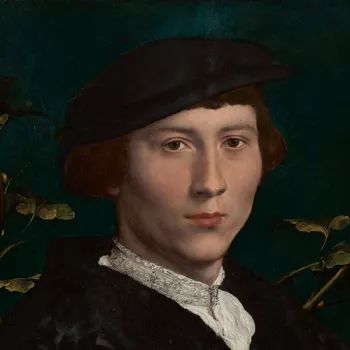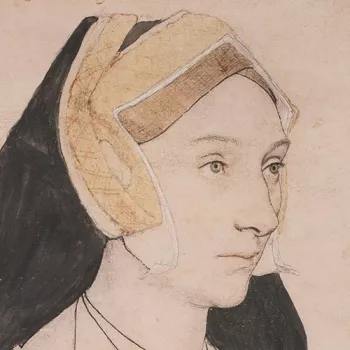
Holbein in the Royal Collection
A closer look at Hans Holbein's works.
Jane Seymour
See Holbein’s elegant drawing of Henry VIII’s third wife.
By Kate Heard, Senior Curator of Prints and Drawings
Reading time: 3 minutes
Jane Seymour (1508/9–37) was Henry VIII’s third wife, and the mother of the future Edward VI. Previously lady-in-waiting to Katherine of Aragon and Anne Boleyn, she married Henry on 30 May 1536 and died shortly after giving birth to Prince Edward in October 1537. This drawing, one of the largest of Hans Holbein’s drawings in the Royal Collection, reflects her status as the wife of one monarch and the mother of another.
Why was this portrait of Jane Seymour created?
Like the majority of Hans Holbein’s portrait drawings, the sheet was made as a preparatory study for a finished portrait. This was probably a panel painting. It dates from the second half of 1536 or early 1537, before Jane’s pregnancy began to be visible. Holbein has shown her standing with her hands clasped in front of her. He has included little detail about the fabrics and decoration of her outfit and this information may have been recorded in other drawings which no longer survive.
Jane’s portrait was circulated widely and the drawing shows evidence of having been reused as a pattern for a number of different paintings. A strip of paper has been added at the bottom to lengthen the composition and the sheet is intersected with drawn and folded lines to act as a guide for different formats.
Many of the surviving portraits of Jane are by unknown artists, but one at the Kunsthistorisches Museum in Vienna is by Holbein himself and is based on this drawing. In the Vienna painting, the Queen wears a rich red velvet dress with wide sleeves decorated with gold thread and an English or gable hood, with one lappet raised. She has a ‘YHS’ brooch (for IHS, a monogram representing Christ), and a large pendant hanging from a pearled necklace, which can also be seen in the drawing. See the Kunsthistorisches Museum painting.
Holbein’s lost mural
This drawing was also used for the most famous depiction of Jane Seymour, in a mural painted by Holbein at Whitehall Palace in 1537. Although this mural was lost in a fire at the palace in 1698, it is recorded in a painted copy made by Remigius van Leemput in 1667. Find out more about the painting.
The mural showed four figures: Henry VIII and Jane Seymour and Henry’s parents, Henry VII and Elizabeth of York, standing around a central plinth which was painted as if carved with verses celebrating the Tudor dynasty. The original mural was painted on the wall of the Privy Chamber at Whitehall Palace and was said to be so lifelike that the figure of Henry VIII shocked those who saw it.
A royal legacy
Demand for pictures of Jane explain the retention of this sheet in Holbein’s studio, and along with other portrait drawings by the artist, it passed into royal ownership after his death.
Jane’s son Edward not only owned the drawings but showed an interest in them. On 12 November 1549 it was recorded that the twelve-year-old prince had taken the book of drawings from the study where they were stored, perhaps to look at the faces of the men and women of his father’s court who Holbein had recorded with such vividness.










